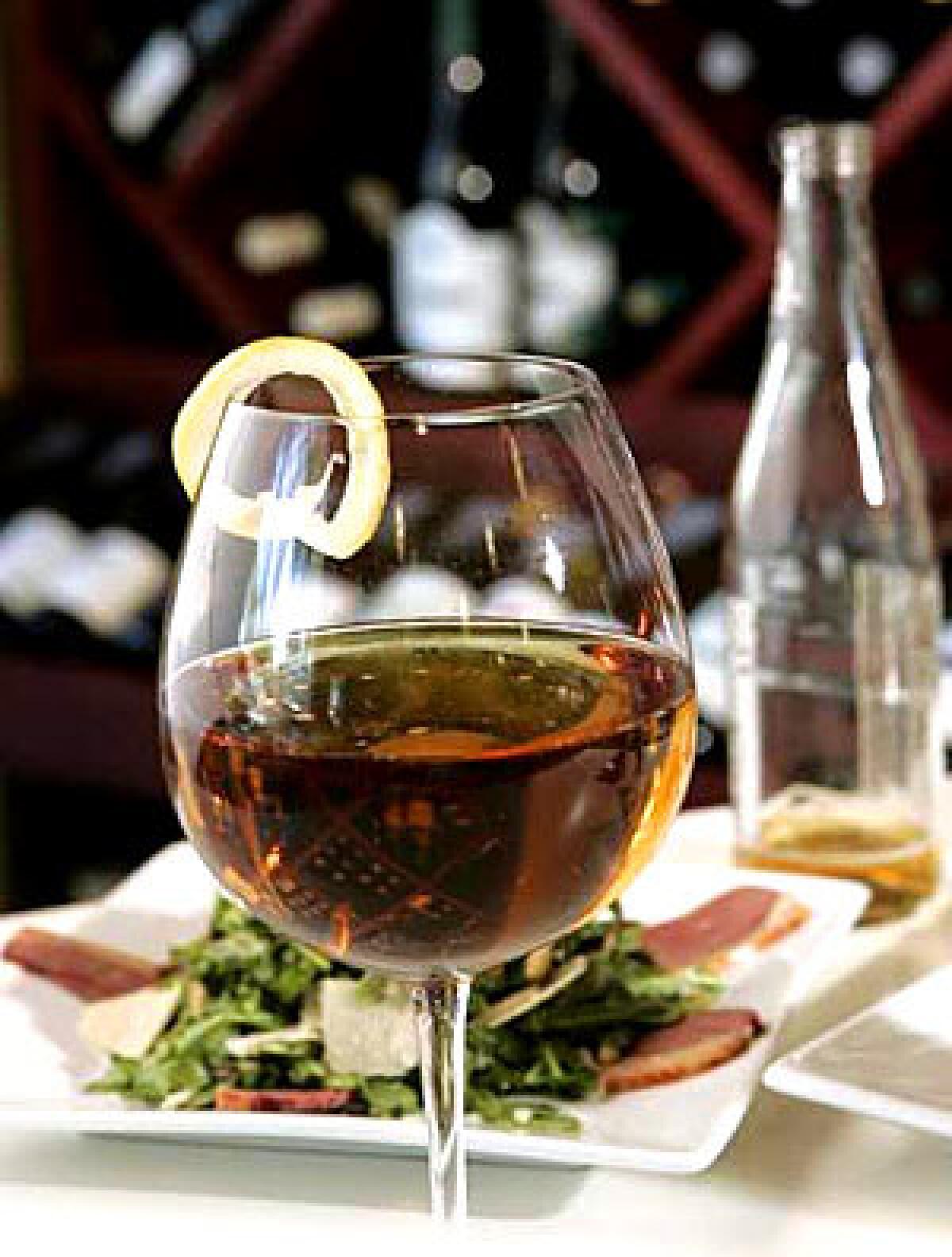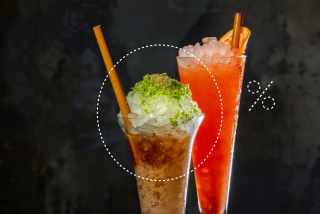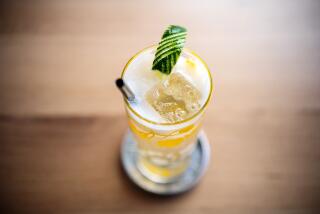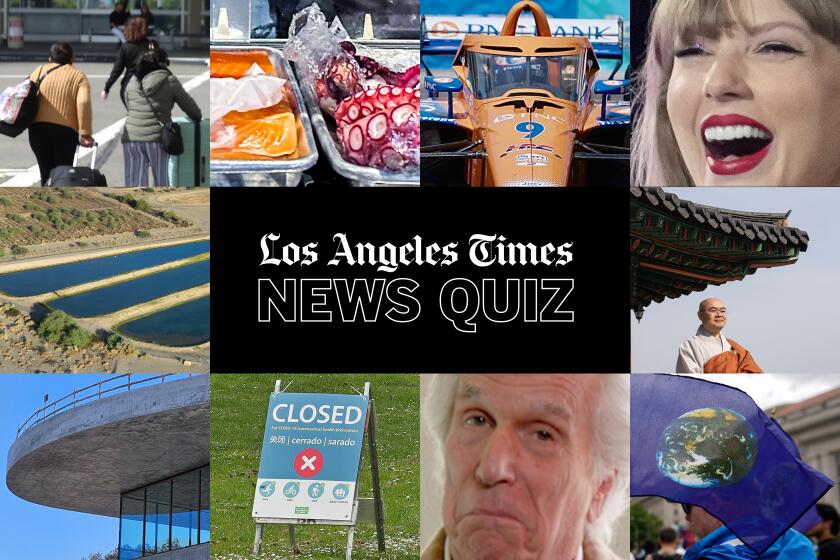Dry sodas -- soft and complex

IT’S A half-hour wait for a four-top at your neighborhood bistro, so you sidle up to the bar for a round. The bartender suggests a glass of the house Champagne, a dry martini or -- a lavender-infused soda.
Welcome to the age of the cocktail-hour dry soda. Small-batch fruit and herbal infusions, classic juice-based sparklers, even wine-flavored sodas are showing up at wine bars, cocktail lounges and specialty supermarkets.
These lightly sweetened, naturally flavored carbonated drinks hover somewhere between sparkling water and classic soda pop -- light on the sugar and with distinctive flavors.
If only figuring out what makes a good dry soda were as easy as popping open a few cold beers.
“I’m not sure exactly how to describe them because they’re so unusual,” admits Mike Olson, beverage manager at BottleRock, the Culver City wine bar that also serves sparkling kumquat, lavender, lemon grass and rhubarb dry sodas. “They’re less sweet than regular soda and have a unique flavor -- I think of them more like a nonalcoholic alternative to wine.”
The best, such as the Seattle-based Dry Soda brand served at Bottle Rock, are fruit and herb infusions with a delicate complexity almost like a sparkling wine (and not surprisingly, these low-sugar sodas typically have fewer calories than regular soda). Others, including the GuS (Grown-up Soda) line of fruit-juice sodas, are heavier on the sugar but still retain the sweet-tart balance of a well-crafted cocktail.
John Nese, owner of Galco’s Soda Pop Stop in Highland Park, attributes the renewed interest in natural sodas (those made with cane sugar and natural flavorings) as the catalyst for the dry soda market.
“Unfiltered natural sodas with fresh fruit and not too much sugar have been around a long time, [but] people are noticing them again.”
Nese regularly stocks lower-sugar sodas from companies including Fentimans, a 100-year-old British producer, and such makers of classic fruit-juice-based Italian sparklers as Pellegrino and San Benedetto.
He’s also seen a rise in artisan fruit soda producers, such as Portland, Ore.-based Hot Lips. In May, Hot Lips launched a line of unfiltered sodas made from Oregon blueberries, blackberries and boysenberries.
Although on the sweeter side, many of these fruit juice sparklers are balanced enough for quaffing during cocktail hour. Fentimans’ Mandarin and Seville Orange Jigger is delicately spiced with ginger root and juniper berries; San Pellegrino’s Chinotto does double duty as a substitute for a bitter aperitif like Campari.
Many are so well-dressed you could serve them straight from the bottle. Some are designed elegantly enough to pass as petite wine bottles, others take a more casual but no less creative approach: 1940s pin-up girls mug for the camera on Abbondio’s shrink-wrapped, candy-colored “vintage-edition” soda bottles.
But in the quest for a dry soda, labels can be deceiving. Despite promising, cocktail-inspired names including Rossa Aperitivo & Bitter, in a recent tasting Abbondio brand sodas proved overly sweet and had off-putting chemical flavors (the soda is the same day-glo red as the bottle).
The new dragonfruit and blueberry-pomegranate flavors of Hansen’s Sparkling Sleek soda, a lighter version of the company’s original cane-sugar soda, were overwhelmed by cloying sweetness (in spite of a moderate calorie count and labels touting them as “sparkling water with flavor from pure fruit”).
Still, several new producers are making balanced sodas specifically with the cocktail crowd in mind. Berkeley-based producer Vignette Wine Country Soda launched its line of wine-grape-based sodas two years ago as a nonalcoholic alternative, and Stirrings, a Massachusetts-based producer of specialty cocktail mixers, notes the “champagne-like bubbles” on the labels of its line of cranberry, grapefruit and bitter lemon dry “cocktail sodas.”
Dry Soda Chief Executive Sharelle Klaus says she founded the company three years ago “as a matter of necessity.”
“By my fourth pregnancy, I had missed out on wine for almost six years,” Klaus recalls. “I was desperate for something sophisticated and balanced enough to pair with food.”
Finding that sugar-flavor equilibrium in a dry soda requires patience. Nese of Galco’s recently began making a line of lighter sodas with a Romanian producer in natural flavors such as cucumber and hand-pressed rose petal, but says he “hasn’t gotten the sugar balance worked out quite yet.”
This fall, Dry Soda will release two new flavors, vanilla bean and juniper berry. Of the latter, owner Klaus says she’s been trying for years to mimic a gin and tonic, her favorite cocktail, but “it was the hardest to figure out how to get right.”
If Klaus has nailed the flavor, balance and complexity, bartenders may soon be serving up juniper berries all night long -- only without the lime. Or the hangover.
More to Read
Sign up for our L.A. Times Plants newsletter
At the start of each month, get a roundup of upcoming plant-related activities and events in Southern California, along with links to tips and articles you may have missed.
You may occasionally receive promotional content from the Los Angeles Times.






